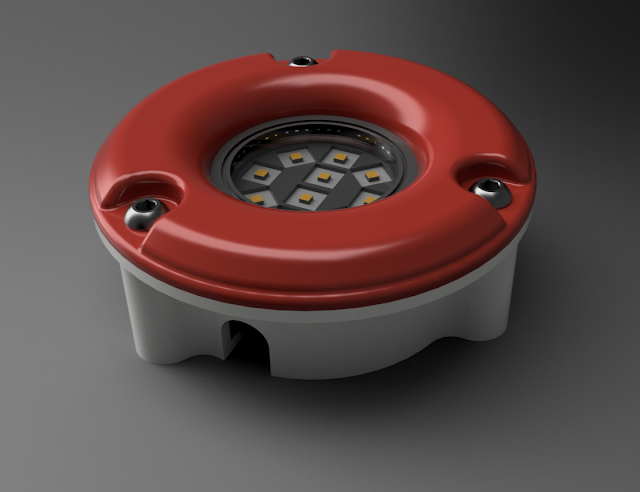It's been a stretch since I last posted so I thought I'd better get caught up while I'm making more 3D printed parts. During the past week or so progress has still been steady with my Captain America ball chair project. With this progress has come some new ideas that will be installed into the chair while the work is moving forward. One big addition to the chair will be the inclusion of an air ventilation system. This will circulate the air in the chair to help supply fresh cool air to the user.
The air ventilation system uses two small computer fans that will draw air in from the bottom of the chair and the blow it into the interior. The computer images above show the ventilation setup for one of the fans. The fan is located in the yellow and silver enclosure shown on the left in both images above. The air is drawn in through the grate, then transferred through the white plastic tubing and then exits out the red adjustable nozzle shown on the right of the images. The red nozzle will be able to be rotated to direct the air either directly on to the user of the chair or away from the person using it. This is similar to the vent setup that is used in most automobiles. Simple and effective.
In one of my last postings I talked about the amplifier sound system that will also be included in the ball chair. The image above is a simple change to this setup that I will be making. The outer cover for the amplifier I originally was going to cover with the same material that I am looking at for the interior of the chair. The only problem with trying to do this with the amplifier outer cover is the shape would be difficult at best to get it covered in material such as what is used in a headliner for a car. So instead I plan on painting the enclosure as shown and then adding the Captain America shield emblem again shown in the image above.
After finding the correct image of the shield online I 3D printed the separate parts. I was able to get them sanded to perfection again using 600 grit wet/dry sandpaper. After a couple of coats of primer, more wet sanding and finally the correct paint colors applied I ended up with the three inch shield that you see in the photo above after the glue had dried. I'm very happy how it turned out. I couldn't do much better than the way it looks so it's another win for the project.
Here's what the back side of the Captain America shield looks like. It is very obvious that the part is 3D printed by looking at this image. The studs on the back of the badge will make it an easy process to mount the badge to the face of the amplifier outer housing. I thought it best to set it up this way should I ever need to repaint either the shield or the housing in the future. Not that I ever want it to happen but you just never know.
Another small assembly that I will be putting together in the next week or so will be the control panel for the three LED lights and the air ventilation setup for the chair. The computer image above gives you a good idea of how this panel will look once it has been assembled. The panel itself will again be 3D printed, sanded and painted to give it a nice smooth look similar to the Captain America badge.
The switches for the control panel simply slide and lock into place and can easily be removed if for some reason down the line one should stop working. The symbols for each switch are again 3D printed on an insert that will glued in place once it has also been sanded and painted white. A simple task which will give the face of the panel a good look. The symbols show one dot for one single light, two dots for two lights, and a wavy set of lines for the air flow switch. If I want all three lights on I simply have to turn on both light switches at the same time. Nice, clean and simple. Works for me. I'll keep making parts and you keep checking in from time to time to see how it's all coming together. Have a good day in your workshop!





















































